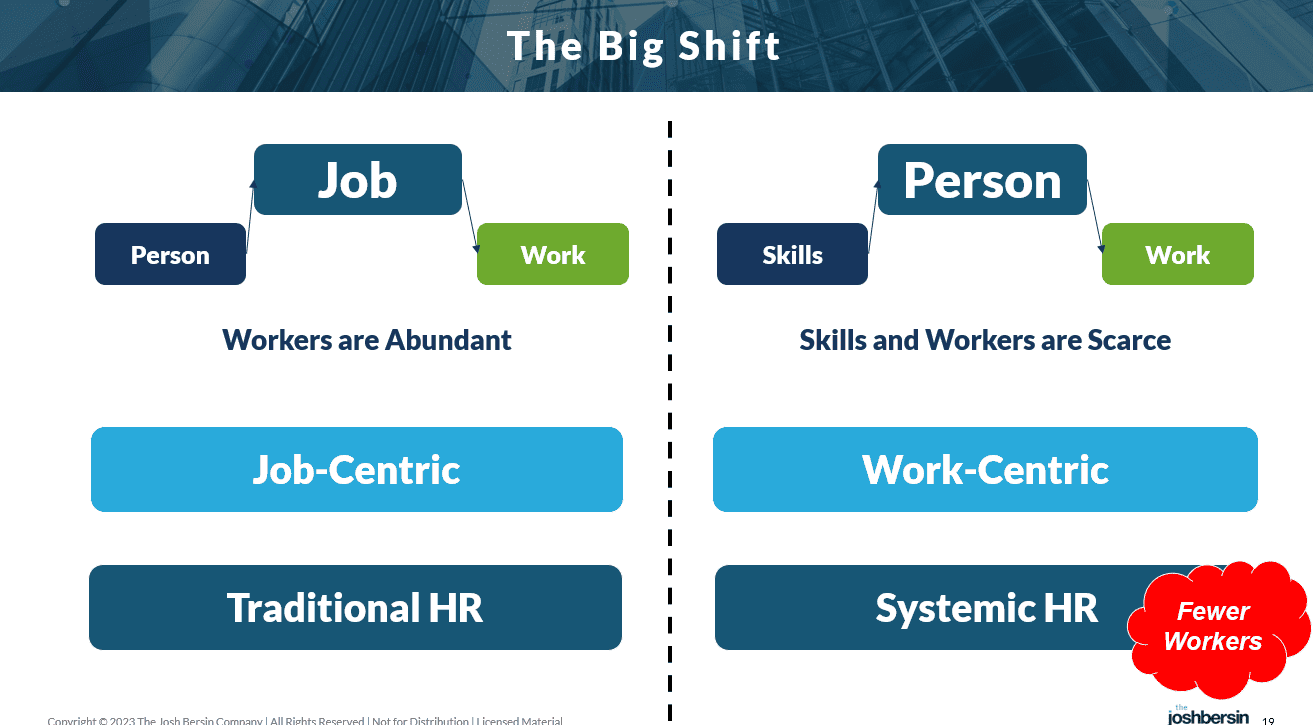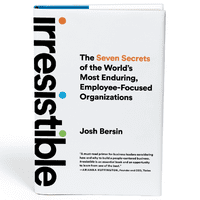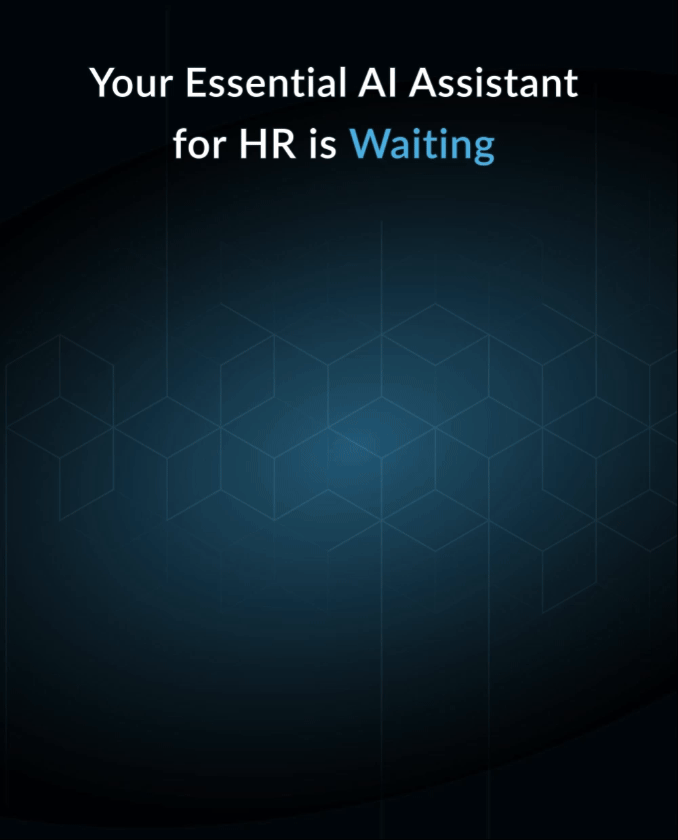Building A Skills-Based Organization: The Exciting But Sober Reality
Fueled by new AI tools and skills technology, nearly every company wants to become a “skills-based organization.” Now that we’ve had a few years to study this trend, I’d like to share some of the realities and calm some of the hype.
The Premise
Let’s start with the premise: the idea promoted by whitepapers is that we’re going to create this unbiased, politics-free company where decisions are based on skills, meritocracy, and performance. Vendors promise that we’ll have a global skills database and through the marvels of Talent Intelligence (primer here) we’ll be able to see trending skills, gaps in skills, and become more scientific about hiring, promotion, pay, and leadership.
Under the covers of this concept is the idea that we can “tag” or “assess” everyone’s skills with laser precision. And many of the AI tools, including the ones we use for our GWI research, promise to do this today. How do they assess our skills? They use the magic of AI to look at our job history, performance, work product, and other sources to infer, model, and predict what we’re good at, what we’re exceptionally good at, and what we need to learn next.
What a glorious vision. And the benefits are many: unbiased competency-based hiring, directed mobility of people to new roles, and strategic planning tools to help us plan pay, locations to hire, and more.
The Reality
This is not a new idea: skills have always been important in business.
I graduated from college in 1978 with a degree in Mechanical Engineering. Upon graduation I interviewed with Procter and Gamble, Boeing, the US Navy, and other organizations. Back then, 45 years ago, every company was interested in my skills. I took tests, answered technical questions, told interviewers about my courses, and demonstrated my proficiency in interviews. (Admiral Rickover, the head of the nuclear navy, asked me specific questions about heat transfer.)
But these companies were not naive. The reason they asked these questions was not to understand what I learned in college, but to understand how I think. I later learned that my behavioral interviews at P&G were designed to decode my personal goals, my mindset, my ability to think, and my ability to communicate. While these may be classified as skills, they are much more complex than figuring out if I knew how to code in Java.
Today, half a century later, it feels like we’re moving backwards. We’re heavily focused on tools and systems to identify technical skills and generic business capabilities. And while these tools and systems are amazing, we have to remember that the most important skills of all (the PowerSkills, as I call them), are yet left out. As my IBM manager used to say, “hard skills are soft,” it’s the “soft skills that are hard.”
In other words, companies succeed based on culture, ambition, learning agility, and alignment. And while we want to assess skills to define jobs, roles, and development, we also have to assume that every person can learn new skills (and must) on an ongoing basis. And this means we want a more holistic (“systemic” in our language) view of skills, moving beyond technical proficiencies alone.
Boris Groysburg, a Harvard professor, studied the performance of world’s top investment bankers. These individuals are highly skilled in financial products, deals, and large transactions. And what did he find? If you take a “highly skilled” investment banker in one company and move him to another, most likely he will not be a high performer any more. His “hyper-performing” skills were actually not his technical skills, they where his unique ability to leverage the organization and know how to get things done.
So building a skills taxonomy can be complex. As our research has found, business skills fall into many categories, each valued in different ways by different companies. And while generic skills certainly matter, it’s the way you use them in your company that drives value.
- Technical proficiencies (coding, software, IT systems, medical procedures, etc.)
- Operational proficiencies (running equipment, fixing a pump, safety procedures, etc.)
- Functional proficiencies (marketing operations, CRM, product management, engineering, design)
- Industry proficiencies (understanding oil and gas industry, chemicals, software business, etc)
- Management and leadership proficiencies (managing teams, leading businesses, etc.)
Each of these is filled with “skills,” so much that companies like Lightcast, who aggregate skills for tens of thousands of job titles, build dynamic libraries with tens to hundreds of thousands of skills. And on top of this we have the big new world of AI-inferred skills, like “handling objections” or “analyzing financial statements” which it figures out on its own.
So What Is New Here? A Lot.
Given these complexities, what’s really new? Well the big change is the interest in building a corporate skills taxonomy, a single “dynamic database” for skills.
This taxonomy is not like the competency models of the past. This is an enormous set of data (tens of thousand of hierarchical skills) and every word in the taxonomy is subject to debate. Should we use “collaboration” or “teamwork?” Should we us “java” or “java programming” or “java language?”
There are hundreds of off-the-shelf taxonomies, and every industry is different. Energy companies have refining, production, and distribution skills. Consumer product companies have brand marketing, product marketing, and channel analysis skills. And Pharma and Chemical companies have scientific, genetic, and regulated manufacturing skills.
Some skills must be verified: entire platforms like Kahuna let you decide who can validate skills and when they have to be revalidated. And other skills need assessments: built on leadership, management, and other soft-skill models.
You can see how complex this is, and remember each company is different. Your company may value innovation and product design skills; your competitor may focus on manufacturing and distribution.
How can we put this all together? Isn’t this a “boil the ocean” type of problem?
Companies tend to take two paths. Path 1 is to build a skills taxonomy team, and then create a long process of working with business units to agree on the language and taxonomy architecture. This may work, but ultimately it has many points of failure. Without really testing these skills in action they’re likely to need tuning, so this often takes a long time.
Path 2, which we recommend, is to start by focusing on a problem. From that problem you build a part of the taxonomy, create a process for design and governance, and learn what tools work best.
Falling In Love With A Problem
Let me give you a real-world example. Suppose you have high turnover and low morale in customer service.
As you dig into the problem (what we call “falling in love with the problem”), you realize the customer service challenges are broad. The team is broken into small groups focused on different product areas, making their jobs boring and repetitive. So you sit down with team leadership and develop a “skills model” for customer service.
As you build the model you discover that very few of the staff are cross-trained. And some are not trained at all! So now, thanks to your skills model, you can decide how to reorganize the group (finding also that some of these “skills” can be automated by ChatGPT), start cross-training, and identify the high performers.
You also now discover that some of your folks are a poor fit. So you use the skills model to find other internal candidates and better source externally. And as you look to hire, you build assessments or interview questions to “hire for these skills.”
American Express actually did this years ago. They realized that the “skills” needed in the Amex sales and service teams were not customer service skills at all, but hospitality skills. Amex treats clients like guests, so they started recruiting from Ritz-Carlton and other hospitality companies. It took a skills-based analysis to figure this out.
As you can see, when you focus on a problem the work can quickly converge and you can solve a real problem. We just interviewed a company that used this approach to more clearly define its cybersecurity roles and found they could save a$20,000 per employee by hiring more junior candidates.
And this kind of analysis helps you decide whether to “buy or build” these skills. In 2020 we did a study of three companies and found that “building technical skills” can be as much as six-times less expensive than buying (hiring).
Such Skills Projects Are Everywhere
There are many use-cases for this approach.
In recruitment, a skills-centric approach lets you expand your network of candidates, often locating internal staff that may be a perfect fit for a job. Through the technology of “skills adjacencies,” we can find people with similar skills who will fit right into a role.
And skills-based hiring reduces bias. A large semiconductor company told us they now use an AI-based skills platform for hiring (Eightfold) and their entire candidate pipeline has more than tripled. They are finding people with excellent skills by blinding name, gender, and academic degree from the resume.
In career development and growth, talent marketplace and internal mobility tools deliver fantastic results. Rolls Royce uses a skills-based model to find manufacturing and production specialists, enabling people to rotate to new jobs in engineering and operations. MetLife, Schneider Electric, J&J, and other companies use a talent marketplace (skills-based employee to job matching system) to promote gig work, career growth, and talent mobility.
In pay and rewards, companies are experimenting with skills-based pay. A large pipeline company told us they now certify repair technicians in various functional areas (pumps, instrumentation, electrical engineering) and when a technician achieves an adjacent skill credential their hourly rate goes up by $5-10 per hour. Imagine all the pay equity data we can analyze against a skills model: this is likely to help us further reduce inequalities regardless of job level or title.
In technology, IT, and science, many organizations feel they can’t keep up. How well prepared is your company for AI, for example? One company we work with is in the middle of building a new skills model for their IT function, and they found that many of their staff are working on technologies that are 15 years old. The new model is helping them recruit, reskill, and energize the entire IT/product function so they can improve hiring, retention, and productivity.
So How Do We Scale This Up?
From a data perspective, companies need to build a business-centric way to manage, govern, and update these models.
Ericsson, for example, built a well-defined skills model for their massive 5G transition. This model was designed by engineers, sales and marketing teams, and the chief learning officer working together. They sat down and decided what areas, roles, and technologies to address, and from there settled on a model from which to grow. Their new journey is to refresh all their IT skills.
BNY Mellon has taken the same approach across IT operations. They’re developed “capability teams” which collaborate on critical job roles (ie. product manager, project manager, analytics) so the teams can keep their skills models up to date.
When you work this way – project by project – the effort gains momentum. You get real results and the business buy-in can scale. We recently helped a large software company build a federated model (business units coordinating effort) to develop a skills model for all their customer education. By doing this in a federated way they can merge and manage their internal skills needs with those of their customers, leveraging content and education in both places.
The Skills-Tech Challenge
But what about the systems? Where should all these skills be stored, and how will we keep them up to date?
While the market is still immature, let me share what we’ve learned.
Many smart AI-powered vendors now offer solutions. Workday, Eightfold, Gloat, Cornerstone, Seekout, Kahuna, Techwolf, Skyhive, Beamery, Phenom, Oracle, SAP, and ServiceNow all have offerings to help you store and define skills, leverage them across different applications, and assess skills through a variety of AI and assessment techniques.
Unfortunately they are each optimized for different purposes. Eightfold, for example, can automatically identify skills within a job description, find candidates, and then identify trending and adjacent skills through its sophisticated models. Cornerstone can show you all the skills covered in your massive learning catalog. Techwolf can infer skills from Jira and Asana projects. And Gloat and Fuel50 can infer skills and match them to career opportunities, jobs, and gigs.
And of course each vendor wants to be “a system of record.” And while many of these vendors have large clients, we have yet to find a company that uses one platform for everything. So while we may, at some point, find a single “skills cloud” capable of storing every skill for every job in the company, that goal has yet to be achieved.
The problem vendors face is the sheer magnitude of the problem. These skills systems are not simply databases: they are AI tools that ideally use second-generation AI to constantly find skills, infer skills, and update skills for every job, person, and career path. They must have open interfaces to the hundreds of skills libraries in the market (every industry and every job family has many taxonomies), and they must have tools to help you manage, analyze, de-duplicate, and curate this data.
And despite the claims, these “skills inference” tools are each different. The recruiting platforms typically are trained with the most data. These platforms (Eightfold, Beamery, Seekout, Phenom, iCims) search and index billions of worker histories and use time series, neural nets, and performance models to infer skills. This means they cover many industries and can identify and analyze skills across many job families across industries.
The talent marketplace platforms (Gloat, Fuel50, Hitch) tend to have less depth only because their goal is just to “make a match within the company.” (Gloat is moving into the overall “talent intelligence” category and now crossing the boundaries.) Gloat has introduced a recruiting product so their platform is clearly becoming an end-to-end talent intelligence system as well (they call it “workforce agility”).
The learning skills tools are least sophisticated (Cornerstone, Degreed, EdCast) because their goal is to match someone to a course or learning path. (Cornerstone is going well beyond this now as well, and has built an entirely new AI fabric to infer skills across its 7,000 customers.)
The ERP vendors (Oracle, SAP, Workday, others) are the least sophisticated, so they are more likely to become “skills aggregators” with APIs to coordinate skills data between these more specialized systems and their internal machine learning models.
In our new AI whitepaper (coming out soon) we talk about how these systems work, and you’ll see that a skills engine has to do many things. It has to infer/access billions of employee profiles, it needs to do time series analysis, and it needs advanced AI (neural nets) to infer, identify and build models that identify skills.
Over time, each skills-tech vendor will go down its own path. Newer vendors like Techwolf, Retrain, and others are looking at corporate data as a source of skills inference, now indexing information in Asana or Jira. This data, while limited, opens a new door: think about the skills information in the Microsoft Graph. Vendors who tap into this information (Viva Topics does this for document management) can learn far more about internal skills. And ultimately this is the type of data you need.
Regardless of the evolving tech market, successful projects focus on a problem. P&G built a skills taxonomy that helped them staff up their supply chain efforts during the pandemic. Reuters built a skills taxonomy to help them build up and scale their data science team. Ericsson’s skills journey started with their 5G re-engineering. And the list goes on and on.
My belief, as we see these projects progress, is that the upside of this work is massive. Companies that embark on this process learn tremendous amounts about their workforce at a rapid rate. They start to understand the governance process. And they build experience with vendors that helps them sort out who can scale to meet their particular needs.
Where This Is Going: From “Jobs” to “Work”
One final point. This work is even more important than you think. As I discuss in Irresistible, this work is part of a bigger shift, away from “rigidly defined jobs” to “roles” focused on work. We call it dawn of the “post-industrial model” of business.
 |
 This transition, which I describe in in my book, means that it’s ok to take the time to do this carefully. It’s ok to set up governance, experiment with different tools, and “fall in love with the problem” one step at a time. Over the coming years, we’re going to build more adaptable, scalable, productive companies as a result.
This transition, which I describe in in my book, means that it’s ok to take the time to do this carefully. It’s ok to set up governance, experiment with different tools, and “fall in love with the problem” one step at a time. Over the coming years, we’re going to build more adaptable, scalable, productive companies as a result.
The Skills-Based Organization is coming, one step at a time. If you take the transformation seriously and consider how important it will become, you can build a plan that works.
Additional Information
Career and Talent Mobility: A New Certificate Program From The Josh Bersin Academy
The Global Workforce Intelligence Project: Skills Gaps Industry by Industry
